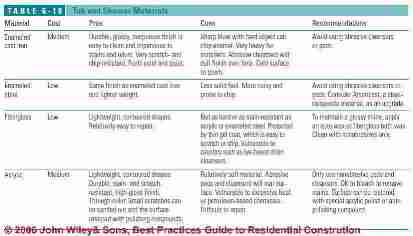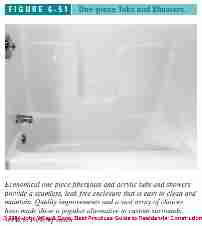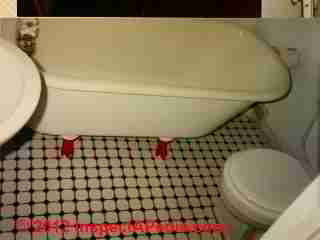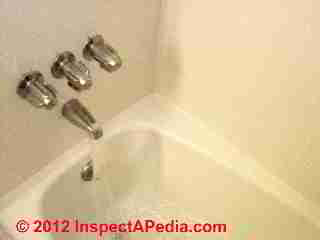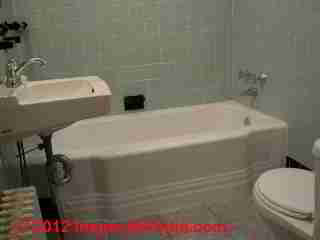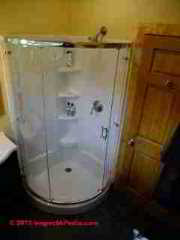 Guide to Choices of Tubs and Tub/Shower Units
Guide to Choices of Tubs and Tub/Shower Units
- POST a QUESTION or COMMENT about choosing & buying a bathtub - types, materials, features, or about buying a shower surround and pan assembly
Bathtub & shower design & product choices:
This article discusses the types of bath tubs and tub/shower units, giving the pros and cons of each, including porcelain-enameled cast iron bath tubs, porcelain enameled steel bathtubs, fiberglass bath tubs and fiberglass shower enclosures, and acrylic bathtub and shower enclosures.
Our page top photo shows the website editor bathing in a rustic bath tub [in 1944]. More modern, comfortable bathtub choices are available and are described here.
Page top photo: the InspectApedia.com website author having his first out-door bath in a wash tub, Dunnsville Virginia, 1943.
InspectAPedia tolerates no conflicts of interest. We have no relationship with advertisers, products, or services discussed at this website.
- Daniel Friedman, Publisher/Editor/Author - See WHO ARE WE?
Guide to Choices of Tubs and Tub/Shower Units
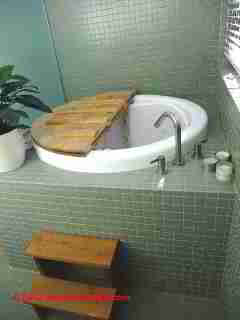
Our photo (left) illustrates a Japanese style bathing tub installed in a Minneapolis home.
The classic tub for many homeowners is still the rock solid, cast-iron model with a porcelain enamel finish. Driven by cost savings on both materials and installation, manufacturers have introduced lighter-weight alternatives using molded plastics (Table 6-10).
While not as hard as the original iron tubs, the plastic alternatives have improved over the years and provide great flexibility for designers
[Click any image or table to see an enlarged version with additional detail, commentary & source citation.]
Most units include integral soap dishes, ledges, grab bars, and other molded features that help bathers and also provide rigidity to the unit. For new construction, most units are one-piece, creating a seamless, leak-free bathing enclosure (see Figure 6-51).
Retrofit tub/shower units typically have four or five pieces that fit together with sealant.
The fewer pieces, the better, as fewer seams means less risk of leakage, less seams that an installer may caulk (a potential site for fungal growth), and a more attractive surface.
Porcelain-Enameled Cast Iron Tub Properties
The classic tub material is very solid, very quiet, and resists scratches, chips, and stains.
On the other hand it is very heavy, cold to the touch, and available only in pretty basic shapes.
It does not easily mold into the body-hugging contours found on many of the plastic units.
Although the surface is the most durable for molded tubs, it is not indestructible. If homeowners use abrasive cleansers and pads, over time the finish will dull.
Our photo (left) illustrates an 1880's cast iron claw-foot tub installed by the editor (DF) during a renovation in Wappingers Falls, NY.
Porcelain-Enameled Steel Bathtub Properties
Porcelain enamed steel used to build a bath tub weighs less than cast-iron and feels less substantial, as the material has some give under the weight of water and bathers. It is also more prone to chip than cast iron.
Our photo (left) shows a porcelain enameled steel bath tub still in good condition in a 1960's home. [However some older porcelain on teel bath tubs we have inspected were prone to chip and then rust damage - Ed.]
A hybrid alternative is American Standard’s Americast, which is a porcelain enameled steel reinforced on the back with a cast polymer.
The material is stiffer and quieter than regular enameled steel, but it is half the weight of cast iron. The company literature claims that the surface is more durable and slip resistant than standard porcelain enamel and that the composite layer helps retain heat.
Fiberglass Bath & Shower Enclosure Properties & Recommendations
Bath Tub Replacement / Re-Liner Options
Our photo (left) illustrates the renovation of a badly-worn cast-iron porcelain lined bath tub in a 1920's home restored by the editor. The tub was re-lined using a modern plastic-type material that matches the profile and appearance of the original tub that was left in place beneath the liner.
New Fiberglass Shower or Bath Tub Properties
Also called FRP (fiberglass-reinforced plastic), or gel coat, this material is manufactured by spraying a thin coat of gel coat into a mold followed by several layers of polyester resin mixed with chopped fiberglass. Between coats, fabricators typically reinforce tub and shower walls and floors with blocks of wood or corrugated cardboard.
One of the premium manufacturers of fiberglass tubs, Aqua Glass, uses a layer of rigid polyurethane foam between fiberglass coats, creating a stiffer assembly that helps the tub retain heat and deadens sound.
The company also adds an antimicrobial compound to the gel coat to inhibit the growth of bacteria and mold. With any FRP tub, the thickness of the gel coat and thickness of the overall lay-up affect its strength and durability.
Our corner shower enclosure (photo at left) with a round gliding door provides ample bathing space in a small bathroom. Photo courtesy Galow Homes.
One way to assess quality is to look for tubs that conform to the voluntary standard ANSI Z-124, which requires that a random sampling of acrylic and gel-coat tubs undergo a variety of durability tests.
The thin gel coat can be damaged, but it is relatively easy to repair with gel-coat repair kits sold in marine and automotive stores. Color matching, however, can be difficult. Also if a chip is not repaired quickly, water can penetrate to the backing and cause the damage to spread.
Overall, a gel-coat surface is less scratch- and stain-resistant than acrylic. Abrasive cleansers must not be used. Many manufacturers recommend an auto wax or special fiberglass bath wax available from tub suppliers.
A proprietary FRP composite called Vikrell™ (Sterling/ Kohler), makes tubs from a mix of resin, color, and chopped fiberglass molded under compression.
The material has no gel coat or layers to chip or crack and has color all the way through. The manufacturer claims that the high gloss finish has the durability of acrylic and the ease of repair of fiberglass at roughly 40% less than the cost of acrylic.
Acrylic Bathtub & Shower Properties
See description (above), under sink materials. One interesting high-end product called Armacryl (Kallista/Kohler) uses a thick clear layer of acrylic over a second color layer.
Like other acrylic fixtures, it is reinforced with a fiberglass backing. The result is a lustrous and thick acrylic finish with excellent durability.
Also see SHOWER PAN INSTALLATION & LINERS
This article series discusses current best design practices for kitchens and bathrooms, including layout, clearances, work space, and accessible kitchen and bathroom layout, clearances, turning space, grab bars, controls, etc. We include advice on choosing and installing kitchen countertops, cabinets, and kitchen or bathroom flooring, sinks, and other plumbing fixtures and fixture controls such as faucets.
A list of kitchen and bath product manufacturers and sources is included. This article includes excerpts or adaptations from Best Practices Guide to Residential Construction (Steve Bliss, J Wiley & Sons) , by Steven Bliss, courtesy of Wiley & Sons.
- - Adapted with permission from Best Practices Guide to Residential Construction (Steve Bliss, J Wiley & Sons) .
...
Reader Comments, Questions & Answers About The Article Above
Below you will find questions and answers previously posted on this page at its page bottom reader comment box.
Reader Q&A - also see RECOMMENDED ARTICLES & FAQs
Question: missing bath tub drain trip lever linkage
(July 5, 2014) Jeff B. said:
I'm currently doing some repair work on a old bath tub that has no existing trip lever linkage to use as a template. I've adjusted the new one so many times, yet the results are the same. I would thoroughly enjoy anyone's feedback on how to solve this problems? I've looked for general information as well as specific videos online that address this problem. Most seem to discuss using the old linkage but what do you do if that isn't available to you?
Reply:
Jeff
I haven't found a generic replacement for a worn out bath tub drain assembly; if one can't re-manufacture or repair old parts, the typical solution is an add-on drain seal that retrofits in the tub drain. There are several pop-up models available. Or for a stop gap measure there is of course the rubber plug.
Question: installing a nail-to-stud shower surround (rather than glue-up) around a cast iron tub
(Aug 1, 2014) Jeannine said:
I would like to use a nail-to-stud shower surround (rather than a glue up surround). Can a nail-to-stud surround be installed with the existing cast iron tub? (The tub has a small lip/flange) and if it can, what are the key items I should know about this installation please, e.g. do I need to put a moisture barrier behind the surround or add an extended flange on the lip of the tub for the nail-to-stud surround to better connect with, etc.
Reply:
Jeannine the add-on shower surrounds I've seen intended to retrofit over a tub include a lower lip that extends out over the tub upper surface wall flange. But you'll want to double check the surround you select against your tub profile for any unusual dimensions.
Properly installed the installation should not leak any water into the wall - I'm not of the OPINION that a plastic vapor barrier buys much. But be sure to seal properly around any penetrations such as for faucets and tub spout.
Question: re-finishing a 1960's porcelain cast-iron tub
(Jan 12, 2015) DHale said:
We are remodeling our main bathroom. Our white alcove tub installed in new construction 1967-68, semi-custom, looks in fine shape. Our area's best refinisher (commercial) inspected it and said he only saw minor scratches/dings and recommended not refinishing it. We believe it is a porcelain cast-iron tub and I'll know once I clean out the closet to access the water valves :). Because we are removing the chalked tile surround to the studs many people tell us to replace the tub, to be safe. However we hate to remove a quality tub.
If your experience includes tubs of this era, what else do we need to know before making this decision? Could the tub be porcelain steel? Again once I gain access to the shut-offs I will investigate.
Thank you for considering our dilemma and sharing your expertise.
Kindly,
DHale
Reply:
If the tub is in good condition, not gouged or cracked, you might indeed want to keep it in place. During remodeling you should check the condition of the supply and drain piping - don't remodel finish surfaces while leaving old, questionable plumbing, drains, or valves in place.
Question: choice of replacement for shower stall surround materials, strength, support for grab bars
(May 18, 2015) Deb said:
I am replacing 25+ year old acrylic-like (do not know make or exact material) shower stall and want to replace with another. I want one that can support grab bars, has minimal flex and is in pieces as this is a remodel. What is latest/stoutest system? If we want grab bars, is it best to purchase a system that already includes those? What additional installation steps should I ask plumber to include to ensure a stout, lasting install?
Thank you for the help.
Reply:
Deb you can choose any shower stall design that fits your space. You'll want to be sure that grab bar mounts are through-screwed into the structural framing behind the unit - the studs. Discuss that requirement with your installer.
(May 18, 2015) Anonymous said:
Thank you. How about the Qwall systems by Dreamline; what advantages or disadvantages do they offer over conventional fiberglass/acrylic panels?
Reply: sorry, no sales pitch here.
...
Continue reading at SPAS WHIRLPOOLS SOAKING & JETTED TUBS or select a topic from the closely-related articles below, or see the complete ARTICLE INDEX.
Or see these
Recommended Articles
- BATHROOM DESIGN
- BATHROOM DESIGN, ACCESSIBLE
- BATHROOM VENTILATION CODES SPECS
- SPAS WHIRLPOOLS SOAKING & JETTED TUBS
- TUB or SHOWER SURROUND ADHESIVE
- PLUMBING FIXTURES, KITCHEN, BATH - home
- TUBS & TUB REPLACEMENTS or RELINERS
Suggested citation for this web page
TUBS & TUB REPLACEMENTS or RELINERS at InspectApedia.com - online encyclopedia of building & environmental inspection, testing, diagnosis, repair, & problem prevention advice.
Or see this
INDEX to RELATED ARTICLES: ARTICLE INDEX to BATH & KITCHEN
Or use the SEARCH BOX found below to Ask a Question or Search InspectApedia
Ask a Question or Search InspectApedia
Try the search box just below, or if you prefer, post a question or comment in the Comments box below and we will respond promptly.
Search the InspectApedia website
Note: appearance of your Comment below may be delayed: if your comment contains an image, photograph, web link, or text that looks to the software as if it might be a web link, your posting will appear after it has been approved by a moderator. Apologies for the delay.
Only one image can be added per comment but you can post as many comments, and therefore images, as you like.
You will not receive a notification when a response to your question has been posted.
Please bookmark this page to make it easy for you to check back for our response.
IF above you see "Comment Form is loading comments..." then COMMENT BOX - countable.ca / bawkbox.com IS NOT WORKING.
In any case you are welcome to send an email directly to us at InspectApedia.com at editor@inspectApedia.com
We'll reply to you directly. Please help us help you by noting, in your email, the URL of the InspectApedia page where you wanted to comment.
Citations & References
In addition to any citations in the article above, a full list is available on request.
- Best Practices Guide to Residential Construction, by Steven Bliss. John Wiley & Sons, 2006. ISBN-10: 0471648361, ISBN-13: 978-0471648369, Hardcover: 320 pages, available from Amazon.com and also Wiley.com. See our book review of this publication.
- Eric Galow, Galow Homes, Lagrangeville, NY. Mr. Galow can be reached by email: ericgalow@gmail.com or by telephone: 914-474-6613. Mr. Galow specializes in residential construction including both new homes and repairs, renovations, and additions.
- Our recommended books about building & mechanical systems design, inspection, problem diagnosis, and repair, and about indoor environment and IAQ testing, diagnosis, and cleanup are at the InspectAPedia Bookstore. Also see our Book Reviews - InspectAPedia.
- Best Practices Guide to Residential Construction, by Steven Bliss. John Wiley & Sons, 2006. ISBN-10: 0471648361, ISBN-13: 978-0471648369, Hardcover: 320 pages, available from Amazon.com and also Wiley.com. See our book review of this publication.
- Gypsum Construction Handbook [purchase at Amazon.com] H17, Technical Folder SA920 and PM2, PM3 and PM4, United States Gypsum Company, 125 South Franklin ST., PO Box 806278, Chicago, IL 60680-4124,
- In addition to citations & references found in this article, see the research citations given at the end of the related articles found at our suggested
CONTINUE READING or RECOMMENDED ARTICLES.
- Carson, Dunlop & Associates Ltd., 120 Carlton Street Suite 407, Toronto ON M5A 4K2. Tel: (416) 964-9415 1-800-268-7070 Email: info@carsondunlop.com. Alan Carson is a past president of ASHI, the American Society of Home Inspectors.
Thanks to Alan Carson and Bob Dunlop, for permission for InspectAPedia to use text excerpts from The HOME REFERENCE BOOK - the Encyclopedia of Homes and to use illustrations from The ILLUSTRATED HOME .
Carson Dunlop Associates provides extensive home inspection education and report writing material. In gratitude we provide links to tsome Carson Dunlop Associates products and services.


